
Science fiction and technology writer
Popular blog posts
Recent forum posts
Discussion Forum
Discussion forumKnotty Geeks Episode 42 - Video Episode #0
Post #: 242
Post type: Blog post
Date: 2015-12-22 10:33:28.000
Author: Jeremy Reimer
Tags: Knotty Geeks (video)
Yes, the vlogging we talked about in such wistful, hopeful terms in the last podcast has actually come to pass! It’s a Christmas miracle!
Join Terry and I in a very special Video Episode #0 of Knotty Geeks!
<iframe width="460" height="265" src=" https://www.youtube.com/embed/qgM-JPd8Mu4"; frameborder="0" allowfullscreen></iframe>
Show notes:
- Forever TV show
- Castles of Steel book
Views: 8520
Knotty Geeks Episode 41 - Vloggy Geeks
Post #: 241
Post type: Podcast
Date: 2015-11-12 11:26:51.000
Author: Jeremy Reimer
Tags: Knotty Geeks
Is Knotty Geeks going to video? We talk about way the show could become a vlog, how you can use Blender to edit video, and what the new YouTube Red service could mean for vlogs in general.
- Knotty Geeks going to vlogs?
- Starcraft II Legacy of the Void discussion
- Blender has video editing!
- YouTube launches YouTube Red subscriptions
- Google tailors web search results to your IP address
- New Compass card is kind of available
- New TV shows: Blind Sight, Mr. Robot, Quantico
Links:
* Blender Video Editing
* Blender Beginner Tutorial
* Simple Video Editing with Blender
* 4k vlogging camera
uploads/Knotty_Geeks_Episode_41.mp3" />
Knotty_Geeks_Episode_41.mp3" width="290" height="24" />
Direct link to podcast
Views: 8290
Knotty Geeks Episode 40 - The Beautiful Intelligence of Stephen Palmer
Post #: 240
Post type: Podcast
Date: 2015-10-21 10:16:18.000
Author: Jeremy Reimer
Tags: Knotty Geeks
We have a special treat on this episode of Knotty Geeks: an exclusive interview with British science-fiction writer Stephen Palmer, author of Beautiful Intelligence, an action-packed yet thought-provoking novel about the emergence of AI.
Terry and I talk to Stephen about how he got started in writing, how he views artificial intelligence and how it might develop, and we even get into the acceleration of technology and genetic engineering!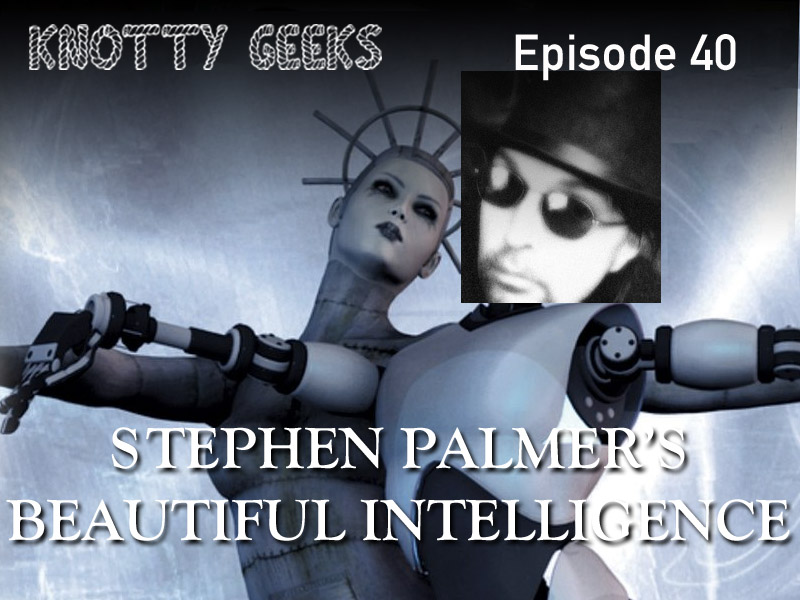
uploads/Knotty_Geeks_Episode_40-trimmed.mp3" />
Knotty_Geeks_Episode_40-trimmed.mp3" width="290" height="24" />
Direct link to podcast
Views: 8811
Knotty Geeks Episode 39 - The Berenstain Bears
Post #: 239
Post type: Podcast
Date: 2015-09-28 14:07:17.000
Author: Jeremy Reimer
Tags: Knotty Geeks
In this episode, we talk about an obscure book by Stanislaw Lem, the end of the Panorama Amiga Computer Club, and the possibility that the Berenstain Bears are proof of the existence of parallel universes.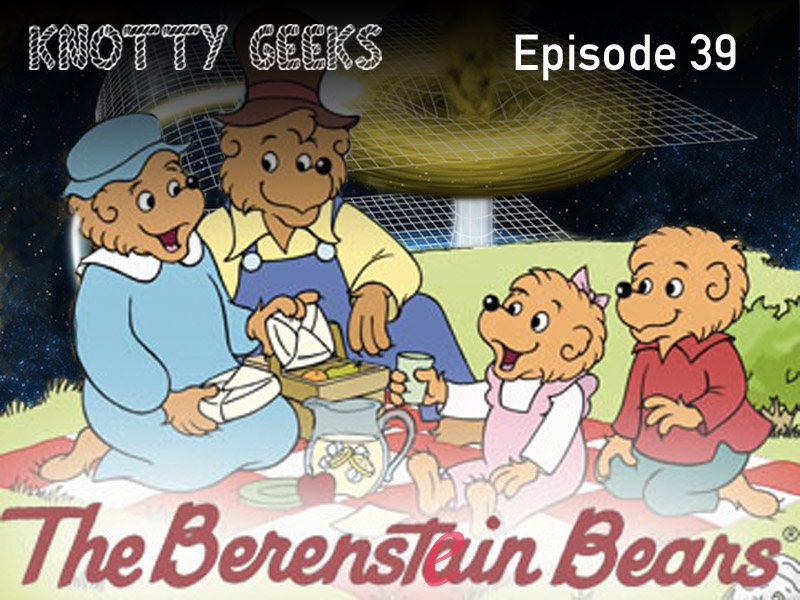
Direct link to podcast
uploads/Knotty_Geeks_Episode_39.mp3" />
Knotty_Geeks_Episode_39.mp3" width="290" height="24" />
The Book No One Read: http://nautil.us/issue/17/big-bangs/the-book-no-one-read
Sci fi podcast Sword and Laser: "LEMming" http://swordandlaser.com
The end of the Panorama Amiga club: http://www.hk-soft.net/panorama/
Berenstain Bears parallel universe: http://www.avclub.com/article/how-you-spell-berenstain-bears-could-be-proof-para-223615
The Gods Must be Crazy old theatre: http://thetyee.ca/Entertainment/2005/04/04/ThisOldMovieHouse/
Google is Two Billion Lines of Code: http://www.wired.com/2015/09/google-2-billion-lines-codeand-one-place/
Did You Know YouTube videos: https://www.youtube.com/watch?v=YmwwrGV_aiE
Computers are breeding humans: http://duncantrussell.com/forum/discussion/14655/computers-are-starting-to-breed-humansno-really/p1
Erin McKean Kickstarter to add a million words to the dictionary: https://www.kickstarter.com/projects/1574790974/lets-add-a-million-missing-words-to-the-dictionary
Views: 8668
Knotty Geeks Episode 38 - Sad Puppies
Post #: 238
Post type: Podcast
Date: 2015-09-14 09:56:27.000
Author: Jeremy Reimer
Tags: Knotty Geeks
In this episode, we talk about the fallout from the recent Hugo Awards, and the ramifications of the Sad and Rabid Puppy campaigns. We also review one of the recent Hugo winners, the excellent novel "The Three Body Problem." 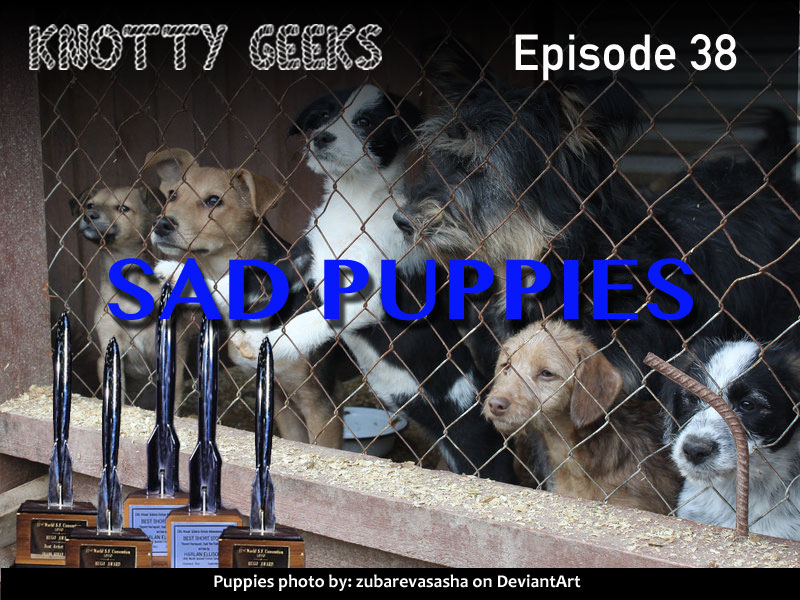
uploads/Knotty_Geeks_Episode_38.mp3" />
Knotty_Geeks_Episode_38.mp3" width="290" height="24" />
Direct link to podcast
Notes from the show:
http://www.wired.com/2015/08/won-science-fictions-hugo-awards-matters/
The Three Body Problem:
http://www.amazon.com/The-Three-Body-Problem-Cixin-Liu/dp/0765377063
Views: 9905
Knotty Geeks Episode 37 - The Creative Apocalypse
Post #: 237
Post type: Podcast
Date: 2015-09-07 12:58:03.000
Author: Jeremy Reimer
Tags: Knotty Geeks
In this episode, we review three great science fiction books, we talk about the upcoming improvements in Intel’s Skylake CPUs, and we discuss the strangely absent Cultural Apocalypse.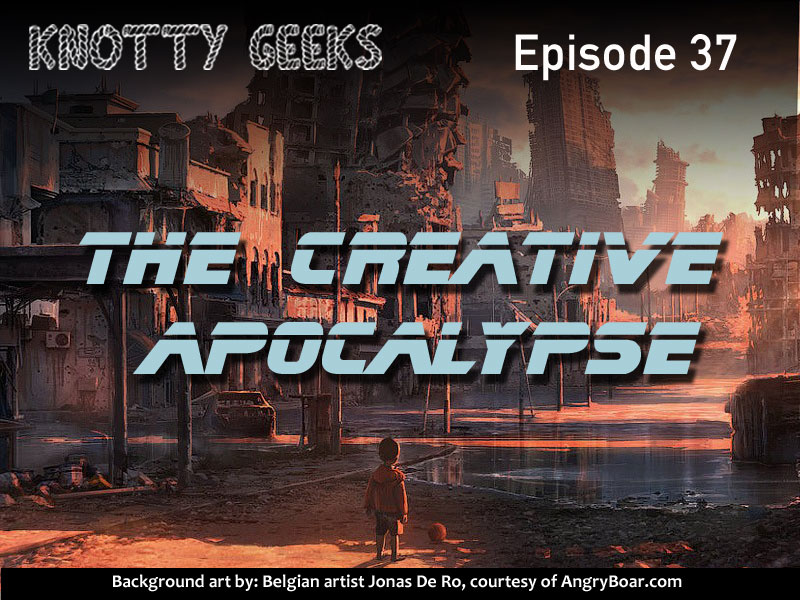
Notes from the show:
Beautiful Intelligence book:
http://www.amazon.ca/Beautiful-Intelligence-Stephen-Palmer-ebook/dp/B010NX6FV6
Gene Mapper book:
http://www.amazon.ca/Gene-Mapper-Taiyo-Fujii-ebook/dp/B00YG0K5M8
Gene inserting tool: CRISPR
Do we live in a simulation?
http://www.pbs.org/wgbh/nova/blogs/physics/2015/07/are-we-living-in-a-computer-simulation/
Reality Hack
http://www.amazon.ca/Reality-Hack-Niall-Teasdale-ebook/dp/B010VJECGC
Discussion of the Creative Apocalypse:
http://www.nytimes.com/2015/08/23/magazine/the-creative-apocalypse-that-wasnt.html
Background art:
http://www.angryboar.com/index.php/apocalypse-by-belgian-artist-jonas-de-ro/
uploads/Knotty_Geeks_Episode_37.mp3" />
Knotty_Geeks_Episode_37.mp3" width="290" height="24" />
Direct link to podcast
Views: 8367
Knotty Geeks Episode 36 - Knotty Geeks 2.0!
Post #: 236
Post type: Podcast
Date: 2015-08-10 09:42:44.000
Author: Jeremy Reimer
Tags: Knotty Geeks
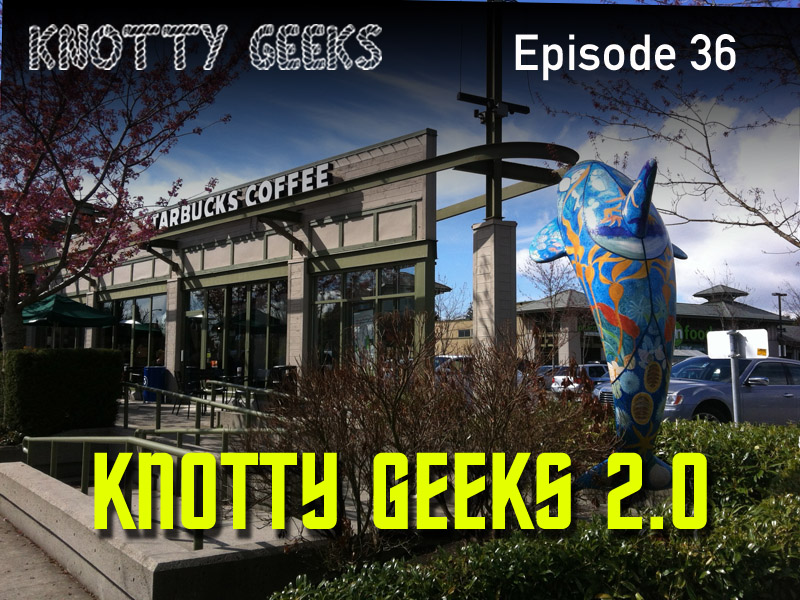
In this episode, we reboot the entire podcast! Well, not really. We’ve come back to our favorite wedge-shaped Starbucks to rediscover what we really loved most about the podcast: the relentless acceleration of technology and the convergence of many technologies into fewer, more powerful ones. We talk a little bit about our writing project, the short story We Choose To Go, and discuss the future of human civilization. You know, just random stuff.
uploads/Knotty_Geeks_Episode_36.mp3" />
Knotty_Geeks_Episode_36.mp3" width="290" height="24" />
Direct link to podcast
Views: 7010
Zoe (1998-2015) The cat that nobody wanted
Post #: 235
Post type: Blog post
Date: 2015-06-08 13:41:42.000
Author: Jeremy Reimer
Tags: Pets
When I first met Zoe she was in bad shape. She was sitting in the back of a cage at the Vancouver SPCA. Her fur was matted and stringy, and she looked like the saddest creature I had ever seen. I put my fingers through the bars and she rubbed her chin on my hand. I fell instantly in love.
Zoe had been a stray as a young cat. She was rescued by the SPCA, then lived with a young family until her eighth birthday. At that point the family had a baby and bought another cat, and Zoe didn’t handle it well. Her card warned that she had issues with unwanted urination.
I watched as other people came into the shelter, petted Zoe, then read her card and walked on. Nobody wants middle-aged cats, and they certainly didn’t want one who had problems with peeing. I was going to pick her up right then, but I had to return the next day with proof that my building allowed pets. I vowed that if Zoe was still there when I got back that I would adopt her. Of course she was still available.
My friend Tzhe was with me and he drove us both home. I opened her cardboard box in the guest bathroom and she immediately jumped out and fled into the hidden depths of our walk-in closet. I had been a pet owner for thirty seconds now and already I felt like a failure. Fortunately Tzhe was able to coax her out and she slowly started to familiarize herself with her surroundings. She was incredibly nervous, but to my relief she did understand what to do when I repeatedly placed her on the litter box. Zoe had found her home.
A scared Zoe seconds after arriving at our home.
I bought a cat brush and groomed her twice a day, and her long hair became soft and lustrous again. She was initially very timid around strangers, but over the years she became more and more relaxed. She would hop up on the sofa as I played games or watched TV, and I would pet her for as long as she wanted. After a while she would hop down to the floor, flop over on her back, and I’d rub her tummy. Sometimes my wife and I would rub her face and ears at the same time and you could see her drinking in the affection like it was the sweetest wine. She never got tired of it. I could pet her until my hand felt like it was going to fall off and she would still want more.
Zoe after a few months, well-groomed and regal.
She was not a bold creature. One day I arrived home from work and she was meowing frantically next to a small bird that had gotten caught behind the blinds. She stood there as I rescued the poor frightened bird and guided it to freedom. Zoe loved to chase and eat flies, but anything larger was just too scary for her to deal with.
Zoe’s favorite game was “cat hockey”, where she would bat around a twist-tie and then leap after it. When we had our hardwood floors put in, we took Zoe with us to a nearby hotel while we literally waited for the dust to settle. After we returned, cat hockey was faster and more exciting.
Zoe expresses her love of the new floors
She wasn’t always easy to deal with. When I changed litter brands, she expressed her displeasure by peeing in my wife’s shoes. I switched back and all was well, but there was always the worry that she would urinate on things. When she got older I got a second litter box so she wouldn’t have to travel as far each time, but sometimes she still had accidents.
In her final years Zoe started to have health problems. Her kidneys and pancreas started acting up, and vet bills became expensive. But she never complained or got upset. She never lashed out at anyone. She was the sweetest creature I’d ever known, right up until the end.
A few days before she died, Zoe seemed to have a burst of energy. She desperately wanted to get into our bedroom, which we had always kept a cat-free zone because of my wife’s allergies. She had never before scratched at the door or tried to push her way in, and would even stop at the boundary if the door was open, knowing that she wasn’t allowed in. This time was different, however. She wanted to get in there one last time. My wife opened her eyes from a nap and saw Zoe sitting next to her, purring as if nothing was wrong.
I miss Zoe. She was my first pet, and I’ll never forget her. She was the cat that nobody wanted, but in the end I wanted her. And that made all the difference.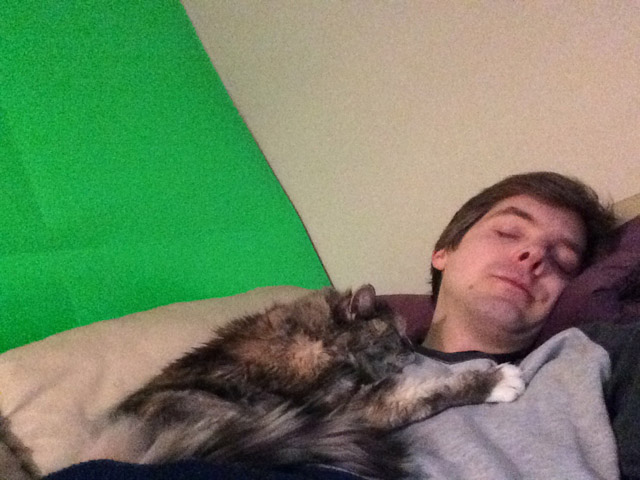
Views: 9142
Update on Furious, my visual novel
Post #: 234
Post type: Blog post
Date: 2015-04-02 09:41:00.000
Author: Jeremy Reimer
Tags: Writing, Gaming

Software developers are notorious for underestimating how much time their projects will take to complete. It’s not borne of ignorance or maliciousness, but rather optimism: one always thinks that everything will go as well as it possibly could. Reality has different ideas.
My initial estimate for completing my first visual novel was an optimistic six months. I’m now thoroughly stuck into development, and my revised estimate is about double that figure, although if I’m in line with estimates made anywhere else by anyone else ever, that figure will probably end up tripling.
Nevertheless, I’m really enjoying the development process. I started (as writers might) with the character outlines and then the script, but I found that keeping track of all the branching paths for the dialog in Scrivener was awkward and looked sort of like pseudocode. So I saved a step and moved into writing the game code itself, in a text editor, using the Ren’Py engine.
As I was essentially writing the game itself at that point, I needed art assets, and I was writing faster than I could create them. So I whipped up some really rough backgrounds and character sketches in Photoshop and used them as placeholders. They look terrible, but they get the job done. At the same time, I started in on some of the 3D assets using Blender, as you can see from this first look at the Furious space carrier, the seat of all the action in the game.
There are eight main characters (not including yourself and the Furious’ Captain) in the game, and six primary locations on the Furious. I’ve outlined the main arc of the plot, and it features eight flight missions with an “intermission” between each one where the player does most of the interaction with the characters. In theory, this should lead to a fairly simple game, but the number of interactions and branching paths can quickly get out of control.
To avoid getting into infinite branches, the primary plot elements are fixed. The main thing the player has control over are dialog options with the various pilots in between missions. Depending on what options the player chooses, pilots will gain or lose points in various internal characteristics, like affection (towards the player), confidence, or skill. These variables will affect the outcomes of future missions.
I’m trying not to make the dialog choices black and white, “you are great/you suck” options. My primary inspiration are the Telltale game series, like Game of Thrones, where you are often presented with two options that both seem bad in different ways. The hard part is making sure that these decisions affect the outcome of the game in a meaningful way. A recent game that does this really well is Dontnod’s Life is Strange, where the player can make significant changes to the plot by paying attention to small details in the environment and dialogue.
For me, writing this game is a huge learning experience, and I’m bound to make some mistakes along the way. Fortunately, my fears about doing a bad job are outweighed by the sheer fun of actually doing it. It’s just about the optimal balance for me of writing, storytelling, programming and artistic design. So stay tuned!
Views: 7320
Breathing new life into an old computer for $50
Post #: 233
Post type: Blog post
Date: 2015-01-30 11:32:25.000
Author: Jeremy Reimer
Tags: Computers
I have a collection of old computers that seem to be approaching the end of their natural lives. The specs on one of them will seem familiar: a Core 2 Duo CPU, Windows XP, 2 GB of RAM, and a 19 inch 4:3 LCD monitor. Lots of people have computers like this. They are about eight to nine years old, and there is nothing particularly wrong with them, but these days they seem sluggish and ancient. They often get confined to closets or the recycling bin. However, there is a way to revive computers of this era, and it doesn’t cost that much. This is a story of how I gave my wife essentially a brand new computer for just over $50.
The first stop was Memory Express to pick up a brand new SSD. I asked the store clerk for a recommendation, and he told me about the Kingston SSD Now 300 series. The low-end, 120 GB version was just over $50, so I picked it up. It has good reviews and I like supporting a company that also supports professional Starcraft teams.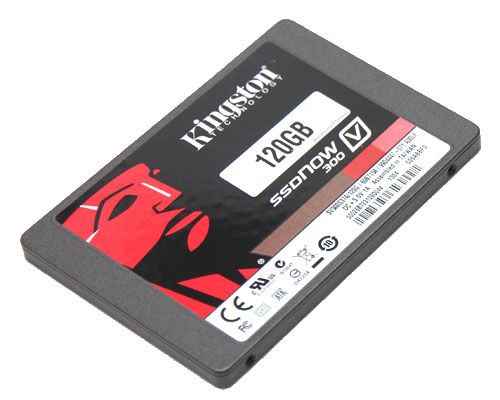
The next choice I had to make was what operating system to install. Windows 8 was right out, because my wife (like many people) has seen and dislikes the new user interface. Windows 7 might be a good choice, but getting a legal copy is expensive, and it’s an old and outdated operating system at this point. In the old days, Windows was a necessary choice because not many apps were web-based, and Linux distributions were still a bit finnicky to get going. Things are different now. But the most popular Linux distro, Ubuntu, has a very unusual user interface, so it wouldn’t be a good choice either.
I settled on Linux Mint 17, with the Xfce interface. It is the most lightweight clone of the standard Windows desktop, so it runs really well on older computers with limited amounts of RAM. It’s also familiar to anyone who has run Windows XP or 7. In fact, you can customize the bitmap image for the start button (and add the word "Start" to it). This makes it look a lot like good old XP, while simultaneously being a modern, secure operating system.
Linux Mint 17 comes pre-installed with Libre Office, which is a great clone of Microsoft Office and has an interface that is similar to Office’s standard menu and toolbar layout from 1995 through 2007. It also reads and writes Office documents seamlessly. Aside from using web applications, being able to write documents and spreadsheets was an important use case for my wife. She likes Libre Office better than the new Office "ribbon" interface that was introduced in 2007, and was using it on Windows XP before I upgraded, so this was a pretty seamless transition.
The only missing element for moving this computer to Linux would be gaming, but as my wife isn’t a gamer (apart from a few apps on her iPad) so that wasn’t an issue.
To install Linux Mint, I disconnected the existing two spinning hard drives and plugged the Kingston SSD into a single SATA port, then burned the .ISO to a DVD-R (I could have used a USB thumb drive, but it would have been a bit trickier, plus it’s been ages since I burned a DVD!) and booted from the shiny new disc. I let the installer format the entire SSD and install the operating system. Only once it was completely installed and running did I plug in the two drives again, setting them as secondary drives in the BIOS. Mint detected them instantly and I was able to copy over all the old documents on the drives to the new SSD. Having done this, I was able to disconnect the drives again to save power when running the computer.
It’s amazing how much faster this machine feels now. Launching LibreOffice takes less than half a second, compared to the half a minute it used to. It looks and feels like a brand new machine, and the price ($50 for the SSD and $0 for Linux Mint) couldn’t be beat.
Views: 9985
So who am I?
I'm a writer and programmer. I write science fiction stories and novels.
I am the writer for the upcoming documentary series Arcade Dreams.
I also write technology articles for Ars Technica.
I'm the creator of newLISP on Rockets, a web development framework and blog application.
- Email: jeremy.reimer@gmail.com
Topics
3D Modeling
About Me
Amiga
Articles
Audio
Blockchain
Blog
Blogs
Book Reviews
Book review
Comics
Computer history
Computers
Computers Microhistory
Computing
Conventions
Crypto
Daily update
Entrepreneur
Family
Forum post
Gaming
Gaming Starcraft
Gaming metaverse
Internet
Jeremy Birthday
Keats
Kickstarter
Knotty Geeks
Knotty Geeks (video)
Market Share
Masters Trilogy
Monarch
Movies
My Non-Fiction
My Science Fiction
NewLISP Blog
Novels
OSY
Operating Systems
Pets
Poll
Reviews
Science Fiction
Servers
Software
Software Operating Systems
Space
Star Gamer
Star Trek
Starcraft
Television
Testing
Toys Childhood
Valheim
Wedding Marriage
Work
Work Life
World
Writing
 RSS Feed for this blog
RSS Feed for this blog